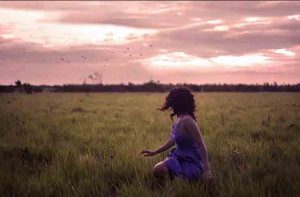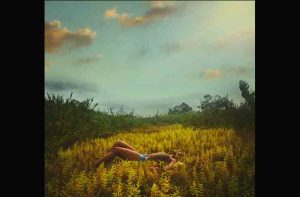A few years ago Khadija Benn wowed Guyana’s online photography community with a series of emotive portraits set against some of Guyana’s most beautiful and tucked away locations. Just when most persons had come to look forward to her occasional posts online, she vanished from social media and left many wondering why.

Benn’s works have since re-emerged in the recently concluded Un|Fixed Homeland exhibition at the Aljira Center for Contemporary Art in Newark, New Jersey, where they were exhibited alongside photographs from twelve artists with varying connections to Guyana.
In a recent interview, we spoke about her participation in the exhibition; the art/photography making process; and her views on social media, its (non) relevance to her art practice and what led to her absence from it.
Dominique Hunter: I was reading the wall text for the exhibition that Grace [Ali] sent for the Un|Fixed Homeland exhibition and in it she was talking about your background and your formal training as a geographer and cartographer. I wanted to know how much of that factored into the production of your work, if at all.

Khadija Benn: It did significantly. Growing up I traveled quite a bit throughout Guyana. Then as part of my work we had to do a lot of fieldwork. So many times we would be out in the field for a few days or a week. That particular image [Amalivaca, 2012] was taken at the end of a really long day of fieldwork in Region 9. Because of the fact that I grew up in Linden and traveled quite a bit, I have an understanding of the local landscapes. I know what good landscape photography is. I’ve done some of it but it’s usually not enough. I’m always interested in inserting a person in there to bring it alive to me or to give it a narrative, so it’s all connected.
DH: In a recent interview with Michael [Lam] we were talking about some of the local photographers’ hesitation to embrace the word “artist.” Is it the same for you?
KB: With regards to it [the work] being artistic, interestingly I’ve never really embraced the title of photographer but I’m more comfortable embracing the title of artist. Grace and I would’ve discussed that at length. Photography, I’ve always just seen as one aspect of things that I’ve done or as long as I can remember I’ve always dabbled in different aspects of it. I’ve always enjoyed reading and looking at art. It just so happened that when I decided to share whatever I was working on, it happened to be my photographs, my images. They’re usually conceptual and emotive portraits, which are inherently artistic. So I don’t have a problem with that. What actually makes me a bit uneasy is the title of photographer because I feel it’s limiting.

DH: What has been your experience of being included in the Un|Fixed Homeland exhibition?
KB: I wasn’t able to make it because of work so I really didn’t experience it. Honestly, I think I missed all of it because I’m not on social media and I’m not even home right now. So in terms of the press and publicity about the exhibition, it probably went right past me. But I was humbled to be part of it certainly. To even conceive that I could’ve been in an exhibition and have my work displayed alongside some of these people who I so greatly admire is really incredible.
From my understanding a lot of them [the other exhibiting artists] are full time artists or they’re in the space whereas for me there is a disconnect. There’s my work where I do a lot of technical writing and there’s this artistic side where I’m working on a painting or a concept for a shoot. There’s tension because it’s really difficult to reconcile the two. They don’t always merge. Even when it comes to my work, sometimes if I decide that I need to work on the concept for a shoot then I need to completely put work aside and out of my head because I’m not able to transition between the two. It’s one or the other. I basically have to decide which is priority and how much time I can give to it. I have to maintain a balance.

DH: For an artist, I find your absence from social media interesting since everyone is now capitalizing on having a presence on every social media platform to get their work known. We’re constantly bombarded by information and you’re completely removed from that. How do you feel about being off the radar but still having your work shared online?
KB: I prefer it. I did the social media thing for a little bit and it’s not for me. When I started with photography, I was on Flickr. So it actually started in a social media environment. I started sharing my pictures because that particular community offered a lot of feedback, not just from portraitists but also from landscape photographers, industrial style photographers. You just got completely different perspectives from this community of people all over the world and that was what I appreciated Flickr for when I was first starting out. That community honed my skills and helped me to develop a style that I felt comfortable with because it wasn’t just good enough to take a picture. It had to be something that felt like me and that was meaningful to me.
I tried the Facebook thing but the difficulty with Facebook for me was that my work was never meant to be commercial. It wasn’t that I didn’t want to photograph people but I felt that if I wasn’t available for commercial work then people weren’t really interested in what I was doing. I knew that there were some people who really wanted to see the nature, abstracts and I used to do some documentary work and the portrait work but commercial work just isn’t for me when it comes to photography. I wanted to focus on developing styles or exhibiting or collaborations with other photographer/artists, and that platform wasn’t allowing me to do that. Or at least at the time I wasn’t able to make that happen because it appeared to be more of a commercial endeavor and that wasn’t my intention. So I just came off of everything and I’ve been doing things a lot slower but a lot more focused.
DH: So after you create your works, how then do you make them accessible to the public? Is that even important to you right now?
KB: Of late no because I’ve put precedence to my career, which would be in cartography, GIS [Geographic Information System], and research work. So that’s what I’ve been doing for the last few years. It’s just not been that important in the last few years to get critique from the photography community. A lot of it is “Nice!” or “Amazing!” or “Great!” and you want so much more. I want heavy critique. I want somebody to tell me “you’re transitioning from what you usually do” or “your style is stagnant”. I found that it hasn’t been useful to do that. So yes, my work hasn’t been visible in recent years and I actually do have to figure out how I’m going to get around that.
I do have a website. I have understood the disadvantages of being “off the radar” as you put it. It’s something that I’ve accepted and it has a lot to do with the fact that the art that I’ve tried to make has never been for anyone but myself. It was never my intention to earn from it or exhibit. I’ve always just done it because I liked it.
DH: How important do you think it was for artists living both at home and abroad to be given the platform of this exhibition to engage with ideas of homeland?
KB: I think it has been important in terms of establishing a sense of direction with regard to photography as art. I remember there was one time when I started publishing a series of images that were very soft, a bit blurry and very different from what I typically do, the tact sharp, very clear narrative. I started getting a lot of comments underneath it saying “It’s blurry. Why would you upload this?” Not seeing that blurriness is also a form of technique. Whether or not I executed it well, it was experimental. It was an attempt to try something different that I hadn’t seen before, at least in Guyana. A lot of the casual photographers don’t get that because it always has to be tact sharp, it always has to follow the rule of thirds, it always has to be a particular way. I think breaking out of the mold is important for that because when we would’ve looked at some of the imagery, some of it was mixed media. So looking at the different ways we can elevate a basic photograph is something that a lot of casual photographers or hobbyists haven’t considered. If Grace had limited the exhibition to just Guyanese artists [living in Guyana] it might not have had that depth, scope and different perspectives of photography as art. It might have been somewhat redundant.
DH: What can we expect from Khadija Benn in the future?
KB: I’ve hit a roadblock with photography because what happens is that if I feel like I’ve taken a picture that feels the same or I’ve done it already then I’m just not going to publish it, share it or mention that I’ve worked on it. I’m more interested in doing more experimental and mixed media work. As I told you about the disconnect between my work and my art and I want to find how I can build a bridge between the two through art or mapping. It would require quite a bit of introspection and introversion to do it because it’s something I’ve been turning over in my mind. I know a lot of people have been asking me about a solo exhibition in Guyana. I’m not keen on it right now because based on my body of work and what I envision a solo exhibition to be, it’s not there yet, it’s not ready. I have an idea of what it would look like. So a lot of what is to come next, if it were to come next, would be new work. And a lot of it would be unlike what I’ve done before.




.png)









